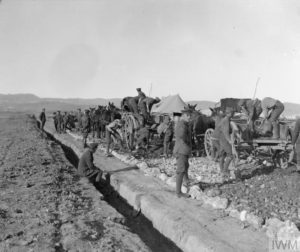Wednesday July 3rd, 1918
Arrive at Bralo, 8:15 and marched to rest camp. Very hot. Much warmer than Macedonia. Tea and dinner in camp then we leave Bralo in motor wagons over mountain passes for Itea. Leave camp at 2:30, 48 wagons in convoy. Very charming and most beautiful scenery. Greek women work on roads. Arrive at rest camp Itea at 6pm. Tea on arrival.
Marching to the Rest Camp

Frank seems to be enjoying the journey through Greece. Since entraining yesterday Frank and his comrades have travelled 330 kms to Bralos. They will break their journey here and join the rest of the 13th who stayed overnight at its Rest Camp.
The 49th Stationary Hospital is based here, together with rest and recuperation camps for Allied troops. A nearby war cemetery contains 100 graves, all but a few from the British Commonwealth. The area will become a battleground in WWII at the Battle of Thermopylae in 1941.†
Motor Wagons to Itea

After lunch, the Battalion of ~850 boards a fleet of 48 motor lorries for the last 50 kms of its journey through Greece. The 13th Battalion is travelling through mountain passes – typical of the terrain of the Macedonian Front on which it has served since October 1915. Away from the fighting and the enemy, Frank finds it charming.
In January 1918, Lt Borgonon was travelling the same route in the opposite direction. His initial reaction was similar to Frank’s:
‘Next day we packed into motor lorries for a long journey over the mountains. This was a most gorgeous trip 50 motor lorries forming the convoy, up steep winding slopes round and round like a great snake. I was in the first lorry and it was most strange to look down from our upper road to see the tail end of the lorries hundreds of feet below.’²
But then the winter weather kicked in:
‘Eventually we reached the top and found quite thick snow, it was awfully cold. Then we started the descent down the other side. I was riding in front beside the driver, he cheered me up immensely when we came to hairpin bends. He said this is the spot where many lorries have dashed over the side. Many accidents have happened and several have been killed. I thanked him for his comforting words and suggested walking, but he said “Oh, don’t be nervous, I never have accidents”, unseen by him I touched wood.’²
The photograph shows a convoy of lorries from 689 Motor Transport Company of the ASC in ~1917.* They have halted on the Seres Road for a tea break – Frank would approve.³
In 2018, Itea is a very small coastal town on the Gulf of Corinth. During WWI it must have been a bustling sea port and was a key point on the mainly overland route through France and Italy for Allied troops and supplies. German U-boat activity had made the Mediterranean crossing increasingly tortuous and fraught with danger.
The Infrastructure of Warfare
When the Allies arrived in Salonika in autumn 1915 they found themselves in a natural, challenging wilderness, unfit for modern warfare.
As Harold Lake recalled, ‘For we came to a country without roads, and undertook to push armies into that country along tracks radiating as do the sticks of a fan. A country without bridges also, and one in which the most innocent trickle of a stream may whirl up into a great river in the course of an afternoon. A country where a way had to be found across swamps, and over great hills a way where no way had been before. And a modern army cannot be content with mere tracks, trodden down though they may be by bare feet and unshod bullocks through the years. A modern army has heavy, cumbersome things to carry with it great guns, ammunition limbers and the rest.’¹
Road Building

Therefore the Allies opened quarries, dug culverts, laid roads and railways, and generally created a new infrastructure capable of supporting the logistics of war.
As illustrated in the photograph, many Infantry Battalions were co-opted to this effort, supporting pioneer battalions and the ASC.
Locals were also employed as labourers – both men and women. As Lake recalled, even rock breaking required more skill than brawn.

‘… we went down to draw tools for the day’s work, that each of us was to be furnished with a hammer. Then was made clear the difference between experience and inexperience.. Those who were old at the game looked over the pile of hammers carefully, and chose little ones, stubbly little chaps with short, stumpy handles. Some of us, on the other hand, had enlarged ideas about our own strength, and a deal of sincere ignorance, and furnished ourselves with implements with which Thor might have been content. We had yet to learn that breaking stones is quite a scientific game, depending not at all on great muscles or mighty, smashing blows.’¹
The women road builders that Frank has spotted presumably were using the stubby, little hammers … ²
13th (Service) Battalion War Diary – 3rd July 1918 – Bralo
B & D Coys and Transport arrived Bralo 08:15 hrs and rejoined the rest at the Rest Camp. The whole Battalion left Bralo on Motor Lorries at 14:00 hrs and travelled to Itea on the Gulf of Corinth arriving 17:30 hrs.
References & Further Reading
† Bralos on Wikipedia
¹ ‘In Salonika with our Army’ by Harold Lake, A Melrose, London, 1917 (pages 20/21 & 38)
² Salonika Diary 1918 by Lt V E Borgonon
* Q 32741 copyright Imperial War Museums
^ Q 31594 copyright Imperial War Museums
** HU 87356 copyright Imperial War Museums
# Q 14720 copyright Imperial War Museums
SaveSave


